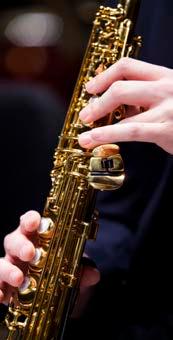




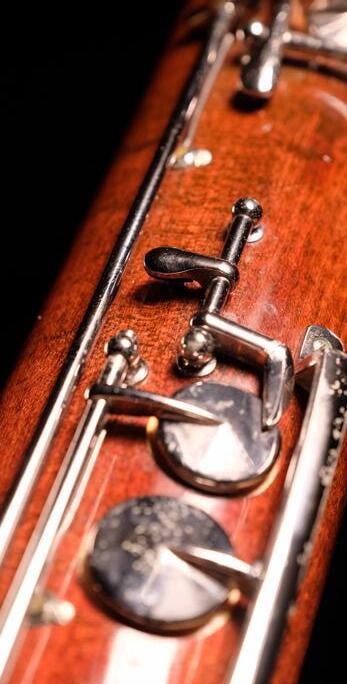



Welcome to the Schwartz Center for Performing Arts. Please turn off all electronic devices. Photography, recording, or digital capture of this concert is not permitted.
404.727.5050 | schwartz.emory.edu | boxoffice@emory.edu
Audience Information
The Schwartz Center welcomes a volunteer usher corps of about 40 members each year. Visit schwartz.emory.edu/volunteer or call 404.727.6640 for ushering opportunities.
The Schwartz Center is committed to providing performances and facilities accessible to all. Please direct accommodation requests to the Schwartz Center Box Office at 404.727.5050, or by email at boxoffice@emory.edu.
The Schwartz Center wishes to gratefully acknowledge the generous ongoing support of Donna and Marvin Schwartz.

Emory University Symphony Orchestra
Paul Bhasin, conductor
Julia Nagel, flute
Saturday, October 26, 2024, 8:00 p.m.
Emerson Concert Hall
Schwartz Center for Performing Arts
Overture to Ruslan and Lyudmila (1842) Mikhail Glinka (1804–1857)
Violin Concerto in B-flat Major, RV 583 Antonio Vivaldi
II. Andante (1678–1741)
Jessica Wu, violin
Appalachian Spring, Suite from the Ballet (1944) Aaron Copland (1900–1990)
Flute Concerto in D Major, op. 283 (1908) Carl Reinecke
I. Allegro molto moderato (1824–1910)
Julia Nagel, flute
Suite from The Firebird (1910, 1919 Revision) Igor Stravinsky
I. Introduction: The Firebird and Her Dance; (1882–1971) Variation of the Firebird
II. The Princesses’ Round: Khorovode
III. Infernal Dance of King Kastcheï
IV. Berceuse
V. Finale
The 95-member Emory University Symphony Orchestra (EUSO) celebrated its 100th Anniversary in 2023. The orchestra performs a repertoire spanning a variety of compositional genres, from the Baroque through the present day. With concert programming featuring both classic and emerging literature, the EUSO has been celebrated in tours (to NYC), recordings (on Atlanta’s NPR affiliate), and collaborations with soloists and organizations including Janelle Monae, Matt Haimovitz, HBO, the National Basketball Association, and Ben Folds. Membership is by competitive audition and comprises of undergraduate and graduate students from diverse disciplines. While the majority of the EUSO includes music majors, many minors and non-majors participate each season as well. The EUSO is recorded on the Centaur Record label, with a 2023 release (iTunes, Spotify) of works for Atlanta and Dallas Symphony wind soloists and orchestra.
The Department of Music at Emory University provides an exciting and innovative environment for developing knowledge and skills as a performer, composer, and scholar. Led by a faculty of more than 60 nationally and internationally recognized artists and researchers, our undergraduate and graduate students experience a rich diversity of performance and academic opportunities. Undergraduate students in our department earn a BA in music with a specialization in performance, composition, or research, many of whom simultaneously earn a second degree in another department. True to the spirit of Emory, a liberal arts college in the heart of a research university, our faculty and ensembles also welcome the participation of non-major students from across the Emory campus.
Become a part of Music at Emory by giving to the Friends of Music. Your gift provides crucial support to all of our activities. To learn more, visit our website at music.emory.edu or call 404.727.6280.
All program notes by Ken Meltzer unless otherwise noted
After schooling in St. Petersburg, Russian composer Mikhail Glinka traveled to Italy and Germany in the early 1830s. There, Glinka heard and studied the music of Beethoven, as well as Italian bel canto operas by Gaetano Donizetti and Vincenzo Bellini. Glinka himself wrote works based on themes from popular Italian operas. But as Glinka recalled: “Feelings of homesickness led me to gradually find my own Russian form of expression.”
Glinka’s search for a “Russian form of expression” culminated in triumph on December 9, 1836, in St. Petersburg. There, Glinka’s opera, A Life for the Tsar, premiered at the Imperial Theater. A Life for the Tsar, based upon an incident in Russian history, and featuring Russian folk melodies, immediately won the hearts of the St. Petersburg audience. Glinka’s A Life for the Tsar is universally recognized as the first Russian national opera.
Glinka’s second opera, Ruslan and Lyudmila, premiered in St. Petersburg on December 9, 1842. Based upon a fantastic tale by Alexander Pushkin, Ruslan and Lyudmila takes place in ninth-century Russia. Lyudmila, daughter of the Grand Prince of Kiev (modern Kyiv), is about to marry the knight Ruslan. When monsters kidnap Lyudmila, Ruslan sets out to rescue his beloved, with (after many adventures) happy results. While complete performances of Ruslan and Lyudmila are rare outside of Russia, the opera’s scintillating Overture has long been a concert hall favorite.
Antonio Vivaldi was one of the most prolific musicians of the Baroque era; not just as a composer, but also as a violin virtuoso and teacher. Vivaldi, the composer, is best known for his approximately 550 concertos, in which he explored a wide variety of instrumental combinations. Among Vivaldi’s concertos are more than 200 for solo violin, including, of course, the beloved The Four Seasons. Vivaldi also composed numerous chamber works, sacred vocal music, and operas.
The Violin Concerto in B-flat Major, RV 583, is scored for a doublestring orchestra, and a specially-tuned (Scordatura) violin. This concert
features the Concerto’s lovely slow-tempo second movement (Andante), in which the violin soars above the string orchestra.
In 1943, the legendary American dancer and choreographer Martha Graham accepted a commission to stage new works for the Festival of the Elizabeth Sprague Coolidge Foundation, held at the Library of Congress in Washington, DC. For that event, Graham, in turn, commissioned music by three prominent contemporary composers—Paul Hindemith, Darius Milhaud, and Aaron Copland.
It was Graham who chose the title for Copland’s piece—Appalachian Spring, taken from the heading of a poem by Hart Crane. Copland began work on the score in June of 1943. Because of various delays, the premiere of Appalachian Spring did not occur until October 30, 1944. Graham and Erick Hawkins danced the principal roles.
Copland scored the original ballet for a chamber group of thirteen instruments. Subsequently, Copland arranged a Suite from Appalachian Spring for a larger ensemble. The Suite received its premiere in 1945. Appalachian Spring takes place in the early part of the ninteenth century, in the hills of Pennsylvania. The story concerns the wedding of a young farmer and his bride.
The Suite is divided into eight sections, performed without pause. The composer offered the following program notes for the Suite’s 1945 premiere:
I. Very Slowly. Introduction of the characters, one by one, in a suffused light.
2. Fast. A sudden burst of unison strings in A-major arpeggios starts the action. A sentiment both exalted and religious gives the keynote to this scene.
3. Moderate. Duo for the bride and her Intended—scene of tenderness and passion.
4. Quite fast. The revivalist and his flock. Folksy feelings—suggestions of square dances and country fiddlers.
5. Still faster. Solo dance of the bride—presentiment of motherhood. Extremes of joy and fear and wonder.
6. Very slowly (as at first). Transition scenes are reminiscent of the introduction.
7. Calm and flowing. Scenes of daily activity for the bride and her farmer-husband. There are five variations on a Shaker theme. The theme, sung by a solo clarinet, was taken from a collection of Shaker
melodies compiled by Edward D. Andrews, and published later under the title The Gift to be Simple. The melody I borrowed and used almost literally is called “Simple Gifts.”
‘Tis the gift to be simple
‘Tis the gift to be free, ‘Tis the gift to come down
Where we ought to be. And when we find ourselves In the place just right ‘Twill be in the valley
Of love and delight.
When true simplicity is gain’d
To bow and to bend we shan’t be asham’d
To turn, turn will be our delight, ‘Till by turning, turning we come out right.
8. Moderate. Coda. The bride takes her place among her neighbors. In the end, the couple is left “quiet and strong in their new house.” Muted strings intone a hushed, prayer-like passage. We hear a last echo of the principal theme sung by the flute and a solo violin. The close is reminiscent of the opening music.
Carl Reinecke’s distinguished musical career embraced the disciplines of composition, teaching, keyboard performance, and conducting. From 1846–1848, Reinecke was the court pianist in Copenhagen. Reinecke taught in Cologne, and, beginning in 1860, at the Leipzig Conservatory. In 1897, Reinecke became the Conservatory’s director. His students included Max Bruch, Edvard Grieg, Arthur Sullivan, and Felix Weingartner. From 1860–1895, Reinecke conducted the prestigious Leipzig Gewandhaus Orchestra.
Among Carl Reinecke’s numerous compositions are two works that remain favorites of the flute repertoire. In 1882, Reinecke composed a Sonata for Flute and Piano, opus 167, based upon the fable of the water sprite Undine. In 1908, two years before his death at the age of 85, Reinecke composed his Flute Concerto in D Major. Reinecke dedicated the Concerto to Maximilian Schwedler, principal flute of the Leipzig Gewandhaus Orchestra from 1881 to 1917. On March 15, 1909, in Leipzig, Schwedler performed the Concerto’s premiere, in a version for flute and piano. Oswin Keller was the pianist. The first performance of the full version for flute and orchestra took place at Queen’s Hall in London on
September 9, 1909. Albert Fransella, principal flute of the Queen’s Hall Orchestra, was the soloist, with Henry Wood conducting.
The Concerto is in three movements. The first, which is being performed this evening (Allegro molto moderato), embodies an introspective and lyrical character.
Stravinsky composed his ballet, The Firebird, at the invitation of Sergei Diaghilev, impresario of the Ballets Russes. Stravinsky began work on The Firebird in November of 1909 and completed the score on May 18, 1910. The composer participated in all the rehearsals at the Paris Opéra. Tamara Karsavina, who danced the title role in the premiere of The Firebird, recalled that during one rehearsal when Stravinsky approached the orchestra pit, Diaghilev turned to her and said: “Mark him well. He is a man on the eve of celebrity.”
The fulfillment of Diaghilev’s prophecy took place on June 25, 1910, with The Firebird’s triumphant premiere. Among the appreciative audience members was Claude Debussy, who came on stage after the performance to offer Stravinsky his compliments.
The Firebird’s brilliant synthesis of lyric and dramatic elements couched in dazzling orchestration captured the imagination of the Paris audiences and catapulted Stravinsky to national and international prominence. Stravinsky fashioned three orchestral Suites from The Firebird, the first (1911) employing the huge orchestral forces of the original score. In 1919, Stravinsky created another Suite for reduced orchestra. Stravinsky completed the third (and final) Suite in 1945. The 1919 Suite—the most frequently performed of the three—is featured in this concert.
I. Introduction: The Firebird and Her Dance; Variation of the Firebird—The Suite opens with a mysterious Introduction. While wandering in the forest at night, Prince Ivan encounters a magic Firebird. The Prince is entranced by the Firebird’s beauty and captures her. However, the Prince takes pity on the Firebird and sets her free. In gratitude, the Firebird gives the Prince one of her feathers and promises to aid him in his hour of need.
II. The Princesses’ Round: Khorovode—The Prince comes to the courtyard of an enchanted castle, where he finds thirteen beautiful Princesses, captives of the evil magician Kastcheï. The Princesses warn Prince Ivan not to enter the castle, for Kastcheï has the power to turn intruders to stone. The Prince boldly ignores their entreaties.
III. Infernal Dance of King Kastcheï—The Prince is suddenly confronted by Kastcheï’s horrible servants, and ultimately, the magician himself. Kastcheï tries to turn the Prince into stone, but the hero produces the Firebird’s magic feather. The Firebird appears and forces Kastcheï and his followers into a frenetic dance.
IV. Berceuse—When Kastcheï and his followers are exhausted, the Firebird lulls them to sleep.
V. Finale—Kastcheï and his retinue are destroyed. All of the prisoners are set free, including the Thirteenth Princess, whom the Prince weds.
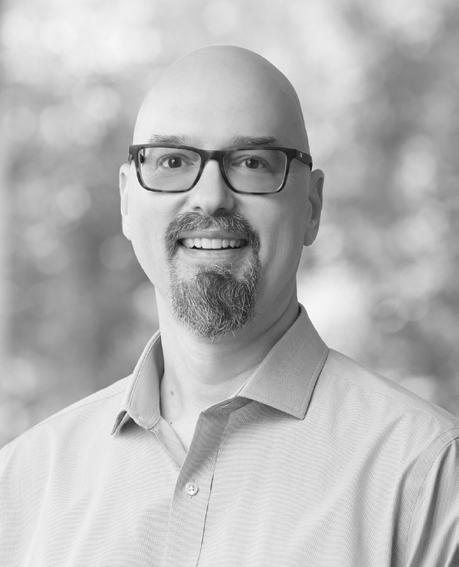
The Schwartz Center for Performing Arts and Music at Emory honor Matt Williamson, whose career as an audio engineer with the Schwartz Center spanned more than two decades. Williamson lost his courageous battle with pancreatic cancer on July 20, 2024, at the age of 48.
Williamson worked with many famous artists throughout his career, and a number of his recordings were played on National Public Radio, but he will primarily be remembered for his passion for all music and for always going above and beyond in service to the live performances at the Schwartz Center. In recognition of his many contributions, the sound booth was named in his honor in 2016 and the acoustic modulation system in Emerson Concert Hall is being dedicated in his memory.
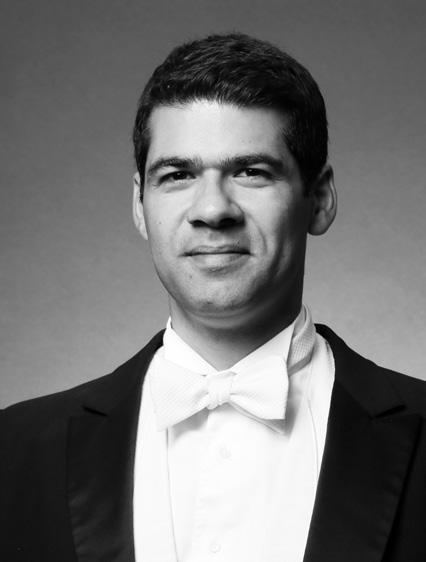
Paul Bhasin serves as Director of Orchestral Studies at Emory University where he holds the Donna and Marvin Schwartz Professorship in Music. In this capacity, he conducts the Emory University Symphony Orchestra, and Emory Youth Symphony Orchestra, oversees music research programs, and teaches conducting. Praised for his “crisp, clear” conducting and “highly expressive” interpretations, Bhasin’s career began when he won the Yamaha Young Performing Artist Competition in 1998. As a conductor, composer/arranger, and instrumentalist, Bhasin has collaborated with diverse institutions including the San Francisco Symphony, Virginia Symphony, “President’s Own” US Marine Band, the International Computer Music Conference, St. Louis Opera, New World Symphony, Interlochen Arts Academy, International Dvořák Festival (Prague, CZ), and Chicago Civic Orchestra. Bhasin has performed on National Public Radio, Detroit PBS-TV, and at the Aspen, Tanglewood, Grand Teton, and Ravinia Music Festivals. Bhasin has recorded as a trumpeter and conductor for the Centaur, ACA, and Interscope record labels.
Bhasin also serves as Music Director and Conductor of the DeKalb Symphony Orchestra and Atlanta Chamber Music Festival. An avid educator, Bhasin has collaborated with the Chicago Symphony Orchestra’s Musicorps program, the Grammy-winning sextet Eighth Blackbird, led honor orchestras and bands (including at the All-State level), and has presented at national conferences including the Midwest Orchestra Clinic and the National Music Teachers Association Conference. Bhasin’s trumpet students have won first prize at major competitions including the National Trumpet Competition.
Bhasin composed and conducted the orchestral scores to the motion picture Sister Carrie (recently premiered at the Gene Siskel Center in Chicago) and Hogtown (award winner at the Berlin, Los Angeles, and Nashville International Black Film Festivals) which was named a “Critic’s Pick” and one of the “Top 10 Films of 2016” by the New York Times (both films stream on Amazon Prime Video). He received his musical education from Northwestern University, the University of Michigan, and the University of Wisconsin-Madison.
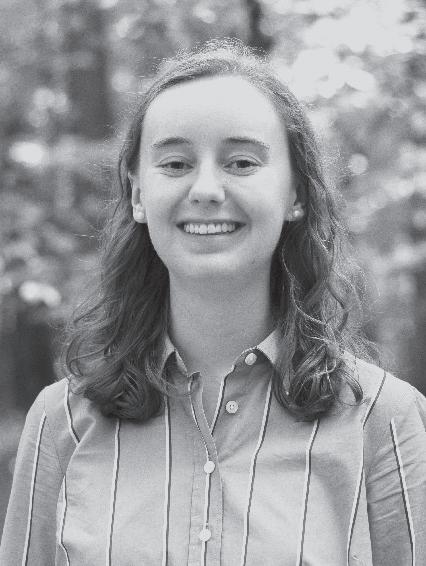
Julia Nagel is a senior at Emory University, double majoring in Music Performance and Philosophy, Politics, and Law. She began studying flute at age eight with Angela Kelly and currently studies under Christina Smith, principal flutist of the Atlanta Symphony Orchestra. Before attending Emory, Nagel was the principal flutist in the Youth Orchestra of Central Virginia and won their Concerto Competition in 2020. She has been selected for various regional, state, and national ensembles, and she attended the summer orchestra program at the Interlochen Arts Camp in 2019 and 2020. In addition, Nagel has participated in numerous masterclasses with renowned flutists such as Judith Mendenhall, Alexa Still, and Paula Robison. Her passion for music is showcased by her involvement in diverse musical opportunities. She received the 2024 Friends of Music Award recognizing her leadership, service, and academic excellence at Emory. In addition to musical performance, Nagel serves on the Emory Music Advisory Board and is the president of Mu Phi Epsilon, Emory’s music service fraternity. She is also the development intern at the Atlanta Symphony Orchestra and spent her summer interning at the Santa Fe Opera in 2024. Nagel thanks Paul Bhasin, Christina Smith, Emory Friends of Music, her friends, and her family for their support and encouragement. She hopes to inspire others to pursue their passions with the same enthusiasm and dedication.
The Joel M. Felner, MD, and Edward Goodwin Scruggs Chairs
The two named chairs, concertmaster and principal second violin, are in recognition of instruments given to the Emory University Symphony Orchestra in the value of $350,000. Joel M. Felner is associate dean at the Emory University School of Medicine; Edward Goodwin Scruggs was for 37 years a tenured member of the Atlanta Symphony Orchestra. The lives of both men represent distinguished careers and great philanthropy as patrons of music and friends of Emory University. The concertmaster plays a 1687 Grancino and the principal second an 1870 Scarampella.
Violin I
Chloe Nelson | Rancho Santa Margarita, CA | Chemistry/Music
Joel M. Felner MD Concertmaster Chair
Performing on the Giovanni Grancino violin, Milan, 1687
Christopher Li, Assistant Concertmaster | Holmdel, NJ | Biology
Ajay Balasubramaniam | Suwanee, GA | Biology/Music
Alex Zhu | Wilmington, MA | Business/Computer Science
Louisa Ma | Phoenix, AZ | BBA
Nora Lee | Short Hills, NJ | Music/Environmental Science
Brandon Lee | Duluth, GA | Biology/Music
Katie Shin | Auburn, GA | NBB/Music
Ayi Ekhaese | Sugar Land, TX | Music/Business
Yujin Ha | Basking Ridge, NJ | Human Health
Samuel Igbo | Boerne, TX | NBB/Music
Caitlin Weinheimer | East Greenbush, NY | Chemistry/Music
Katherine Mombo | Southbury, CT | History/Music
Youyou Zhu | Johns Creek, GA | NBB
Karen Wang | Andover, MA | Chemistry
Akhila Jallepalli | Austin, TX | NBB
Violin II
Kaitlyn Kaminuma | Chelmsford, MA | Music/QSS
Edward Goodwin Scruggs Principal Second Chair
Performing on the Giuseppe Scarampella violin, Brescia, 1870
Isabella Lin, Assistant Principal | Alpharetta, GA | Music/Biology
David Chung | Atlanta, GA | Finance
Robin Meyer | Grand Rapids, MI | Music/Environmental Science
Violin II (continued)
Mia Motley | Marietta, GA | NBB/Music
Chloe Busracamwongs | Millbrae, CA | NBB
Josephine Sim | Woodway, TX | NBB
Amartya Kallinagal | Atlanta, GA | Computer Science (GT)
Eric Zhang | Dublin, OH | Applied Math/Music
Sunny Sun | Vancouver, Canada | Film
Izzy Hipple | Beaufort, SC | Biology
Jessica Liu | San Jose, CA | NBB
Ryana Rajesh | Wilmington, DE | QSS-NBB
Edric Nduwimana | Rex, GA | Music
Quentin Brydon | Ann Arbor, MI | Nursing
Alex Kashanchi | Potomac, MD | Biology
Viola
Sihyun Jeon, Principal | San Jose, CA | Biology/Chemistry
Rachel Lee, Assistant Principal | Atlanta, GA | Biology
Christian Chae | Arcadia, CA | BBA
Caroline Ma | Phoenix, AZ | BBA
Cynthia Min | Chandler, AZ | BBA
Jihwan Shin | Suwanee, GA | Psychology
Dylan Rybacki | San Antonio, TX | Applied Math
Chanhee Park | San jose, CA | BBA
Lillian Liao | Sugar Land, TX | NBB
Michelle Lu | St. Louis, MO | NBB
Hannah Lim | Newton, MA | Nursing
Thora Spence | Oak Ridge, TN | Math/Biology
Stephen Kwon | Kansas City, MO | Undecided
Jenny Zheng | Potomac, MD | Business
Cello
Sergey Blinov, Principal | Atlanta, GA | Physics/Math (GT)
Alexander Moon, Assistant Principal | Berkeley Heights, NJ | Chemistry
Daniel Yoon | San Jose, CA | Business
Jaia Alli | Atlanta, GA | Biology/Music
Christopher Jang | San Marino, CA | Biology
Cello (continued)
Audrey Chun | Lexington, MA | NBB
Sabrina Sung | Westford, MA | Public Policy
Chris Park | Rye, NY | Chemistry
Sean Yoshihara | Schaumburg, IL | Computer Science (GT)
Paul Kim | College Station, TX | NBB
Ben Uslan | Charlotte, NC | Music/German
Meiya Weeks | Cambridge, MA | PPA
Joshua Kim | Suwanee, GA | Undecided
Bass
Jonathan Jacques, Principal | Shaker Heights, OH | Biology
Charles Ascone, Assistant Principal | Manalapan, NJ | Computer Science/Music
Tess Kassinger | Chicago, IL | Biology
Carsen Valenta | Weston, MA | NBB
Tucker Sampson | Duxbury, MA | Computer Science/Music
Jordan Li | Manhasset, NY | Physics
Flute and Piccolo
Listed Alphabetically
Ashan Galhena | Suwanee, GA | NBB/Music
Robyn Jin | Bellevue, WA | Biology
Brooke Liu | Irving, TX | BBA
Julia Nagel | Crozet, VA | Music/PPL
Oboe and English Horn
Listed Alphabetically
Isaac Light | Pleasanton, CA | Business/CS
Eric Xu | Short Hills, NJ | Applied Math/Chemistry
Malia Yap | Pacific Palisades, CA | QSS - Sociology
Clarinet
Listed Alphabetically
Jamie Eck III | Summit, NJ | Economics
Narin Kim | Schaumburg, IL | Nursing
Nicholas Wandrick | Alpharetta, GA | NBB/Music
Bass Clarinet
Jamie Eck III | Summit, NJ | Economics
Bassoon
Listed Alphabetically
Nolan Smith | Pleasanton, CA | Undecided
Donovan Tong | San Ramon, CA | BBA
Horn
Listed Alphabetically
Andrew Antoun | Frisco, TX | Biology
Noah Choe | Dubai, United Arab Emirates | Biology
David Kim | San Jose, CA | Physics
Zhi Lin | Johns Creek, GA | Business
Trumpet
Listed Alphabetically
Wanyi Cai | Beijing, China | Religious Studies/Computer Science
Joey Chen | Beijing, China | Music/Math
Max Curtis | Natick, MA | Biophysics/Music
Trombone and Bass Trombone
Listed Alphabetically
Timothy Brewer | Mason, OH | Environmental Science/PPL
Misha Gupta | Marietta, GA | Business/Music
Angela Hu | Cary, NC | Computer Science
Christopher Park | Lilburn, GA | Biology
Tuba
Kushal Maganti | Suwanee, GA | Neuroscience
Percussion and Tuba
Listed Alphabetically
Eric Chen | Taichung, Taiwan | Biology/Applied Math
Jace Park | Newnan, GA | Business
Jack Xu | Mendham, NJ | Undecided
Alan Zhao | Fremont, CA | Biology
Harp
Listed Alphabetically
Emma Burnsworth | Winston, GA | Music
Brigid May | Holly Springs, NC | Music Performance/Classics English
Piano and Keyboard
Jonathan Luo | Mason, OH | Undecided
Violin
Justin Bruns •
Jay Christy •
Emily Daggett Smith H
Jessica Wu H
Viola
Yinzi Kong
Paul Murphy •
Joseph Skerik H
Clarinet
Jesse McCandless •
Justin Stanley
Bassoon
Anthony Georgeson •
Shelly Unger
Trumpet
Mark Maliniak •
Michael Tiscione •
Trombone
Ed Nicholson s
Nathan Zgonc •
Percussion
Sarah Dietrich
Scott Pollard
Mark Yancich •
Euphonium
Adam Frey
Flute
Christina Smith • Jim Zellers s
Oboe
Emily Brebach • Sasha Shatalova Prior
Tuba
Michael Moore •
Saxophone
Gary Paulo
Horn
Jason Eklund s
Ryan Little •
Harp
Elisabeth Remy •
Cello
Karen Freer •
Roee Harran
Guang Wang H
Bass
Michael Kurth •
Joe McFadden •
• Atlanta Symphony Orchestra
s Atlanta Opera Orchestra
H Vega Quartet
Stephen Crist, Chair
Meredith Schweig, Director of Undergraduate Studies
Paul Bhasin, Director of Undergraduate Research
Martha Shockey, Senior Secretary
Kathy Summers, Academic Department Administrator
Magdalena Shumanova, Academic Services Program Coordinator
Simone McGaw Evans, Program Coordinator
Visit schwartz.emory.edu to view complete event information. If a ticket is required for attendance, prices are indicated in the listings below in the following order: Full price/Emory student price (unless otherwise noted).
Sunday, October 27, 7:00 p.m., Emory Choirs, Schwartz Center, Emerson Concert Hall, free
Friday, November 1, 8:00 p.m., PUBLIQuartet—Rhythm Nation, Schwartz Artist-in-Residence Program, Schwartz Center, Emerson Concert Hall, $30/$10, tickets required
Saturday, November 2, 8:00 p.m., Friends and Mentors, ECMSA: Emerson Series, Schwartz Center, Emerson Concert Hall, free
Sunday, November 10, 4:00 p.m., Emory Chamber Ensembles, Schwartz Center, Emerson Concert Hall, free
Sunday, November 10, 7:00 p.m., Emory Collaborative Piano, Performing Arts Studio
Monday, November 11, 7:00 p.m., FRL with Nikola Peković, Performing Arts Studio
Wednesday, November 13, 8:00 p.m., Emory Youth Symphony Orchestra, Schwartz Center, Emerson Concert Hall, free
Wednesday, November 13, 8:00 p.m., Bojana and Nikola Peković Perform Serbian Folk Fusion, Performing Arts Studio
Saturday, November 16, 8:00 p.m., Eternal Love Triangle, ECMSA: Emerson Series Waits Chamber Music Concert, Cannon Chapel
Saturday, November 16, 8:00 p.m., American Railroad: Silkroad Ensemble with Rhiannon Giddens, Schwartz Center, Emerson Concert Hall, $70/$10, tickets required
Friday, November 22, noon, Danielle Hahn Piano Trio, ECMSA: Cooke Noontime Series, Schwartz Center, Emerson Concert Hall, free
Saturday, November 23, 3:00 p.m., Emory Javanese Gamelan Ensemble, Cannon Chapel
Saturday, November 23, 8:00 p.m., Emory University Symphony Orchestra, Emory Wind Studies, and Tango Artists, Schwartz Center, Emerson Concert Hall, free
Sunday, November 24, 4:00 p.m. (rescheduled), Jack Mitchener, University Organist, Schwartz Center, Emerson Concert Hall, free
Tuesday, December 3, 8:00 p.m., Emory Big Band and Jazz Combos, Schwartz Center, Emerson Concert Hall, free
Wednesday, December 4, 8:00 p.m., Fall Composition Showcase, Performing Arts Studio
Friday, December 6, noon, Norman Krieger, piano, ECMSA: Cooke Noontime Series, Carlos Museum, Ackerman Hall, free, registration required
Friday, December 6, 8:00 p.m. and Saturday, December 7, 4:00 p.m. and 8:00 p.m., A Festival of Nine Lessons and Carols, Glenn Auditorium, $20/$10 (all students), tickets required
Sunday, December 8, 4:00 p.m., Santa’s Favorite Chamber Music, ECMSA: Family Series, Carlos Museum, Ackerman Hall
Learn More About the Emory University Symphony Orchestra’s 2024–2025 Season at emorysymphony.org
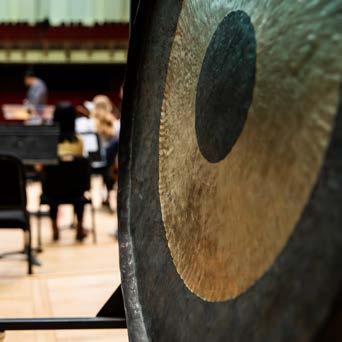

Music at Emory brings together students, faculty, and world-class artists to create an exciting and innovative season of performances, lectures, workshops, and master classes. With more than 150 events each year across multiple Emory venues, audiences experience a wide variety of musical offerings.
We hope you enjoy sampling an assortment of work from our student ensembles, community youth ensembles, artists in residence, professional faculty, up-and-coming prodigies, and virtuosos from around the world.
music.emory.edu
